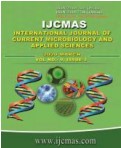


 National Academy of Agricultural Sciences (NAAS)
National Academy of Agricultural Sciences (NAAS)

|
PRINT ISSN : 2319-7692
Online ISSN : 2319-7706 Issues : 12 per year Publisher : Excellent Publishers Email : editorijcmas@gmail.com / submit@ijcmas.com Editor-in-chief: Dr.M.Prakash Index Copernicus ICV 2018: 95.39 NAAS RATING 2020: 5.38 |
Four dietary treatments were evaluated for their effect on growth performance of crossbred (LWY x Desi) male pigs during grower and finisher phases in a Completely Randomized Block Design. A Basal ration (T1) + 100g of Probiotic (Bacillus) + 500 g of enzyme cocktail per ton of feed, T1 + DDGS to contribute 20% of the total protein (9% & 7.5% of diet during grower and finisher phases, respectively (T2); T1 + DDGS to contribute 30% of the total protein (12.5% & 11% of diets during grower and finisher phases, respectively(T3); T1 + DDGS to contribute 40% of the total protein (16.5% & 15% of diets during grower and finisher phases, respectively(T4). During grower phase, the pigs fed T1 have taken less (P<0.05) number of days than those fed T4. ADG (g) was higher (P<0.05) in T1 (440) or T2 (432) fed pigs than in T3 (413) and T4 (382) fed pigs and during finisher phase, initial, final and total weight gain (kg) were not significantly different among treatments. Number of days taken was T1 (90), T2 (92), T3 (88), T4 (96) and were not significant. ADG (g) in T1 to T4 diets fed pigs was 400, 392, 405 and 370, respectively. The ADFI (kg), the feed per kg gain and the cost of feed per kg gain (Rs) were not significantly different among treatments. During overall growth performance, ADG (g) was higher (P<0.05) in T1 (423) followed by T2 (412), T3 (409) and lowest in T4 (372) fed pigs. The ADFI (kg) and the feed per kg gain were not significantly different among treatments. The cost of feed per kg gain (Rs) was higher (P<0.05) in T1 (98.8) or T2 (93.8) fed pigs than in T3 (92.2) and T4 (84.3) fed pigs. It was concluded that contributing (%) 20 and 30 of the CP through DDGS improved ADG and reduced the cost of feed gain per kg gain in growers and finishers, respectively.
 |
 |
 |
 |
 |